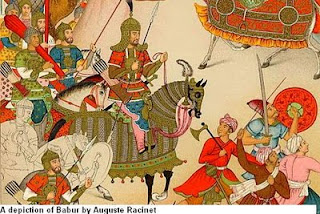 Zahirudding Muhammad Babur, better known simply today as Babur, who defeated Ibrahim Lodi of the Lodi Dynasty of the Delhi Sultanate at the first battle of Panipat on the 21st April, 1526, founded the Mughal empire in India. However, it seems that this Central Asian adventurer was not interested in setting up of an empire in India.
Zahirudding Muhammad Babur, better known simply today as Babur, who defeated Ibrahim Lodi of the Lodi Dynasty of the Delhi Sultanate at the first battle of Panipat on the 21st April, 1526, founded the Mughal empire in India. However, it seems that this Central Asian adventurer was not interested in setting up of an empire in India.
According to eminent historian R. P. Tripathi, Babur’s conquest of Hindustan was “a result of chance thought”. As a matter of fact, he was invited to invade the Lodi ruler by some of the disgruntled nobles of the Delhi sultanate. According to some authorities, Rana of Mewar, Sangram Singh or Rana Sanga, had also entered into some kind of deal with Babur.
Babur was a descendant of Timur on his father’s side and of Chengiz khan on the side of his mother. The Mughals loved to call Timurids because they were so proud of their connections with Timur. On the death of his father Umar Shaikh Mirza, Babur inherited the ancestral principality of Farghana (now in Uzbekistan) in 1494.
The first battle of Panipat was just the beginning of the Mughal rule. The real foundation of Mughal rule was laid by the greatest Mughal ruler Akbar in 1556.
When Babur defeated Ibrahim Lodi, the political power in India was being shared by the Rajputs and the Afghans.
But Babur’s conquest of India would have been incomplete till he defeated the Rana Sanga, who was the most powerful Rajput ruler of the period and certainly a more formidable adversary than Ibrahim Lodi.
Consequently, a decisive battle took place on the 16th March, 1527 at Khanua, a village some 60 km west of Agra, between the forces of Babur and Rana Sanga. In this battle Rana Sanga, who was joined by the rulers of Marwar, Gwalior, Ajmer, Amber and Chanderi and Sultan Mahmud Lodi (brother of Ibrahim Lodi), was comprehensively defeated and Khanua cemented Babur’s victory at Panipat. In 1528, he captured Chanderi from a Rajput Chief Medini Rai despite the desperate opposition of the Rajputs. On 6th May 1929, Babur inflicted a crushing defeat on the Afghan chiefs under Mahmud Lodi at the battle of Ghagra in Bihar. These conquests made Babur the master of Northern India, but he was not able to enjoy the fruits of his conquests because shortly afterwards he died at Agra at the age of forty seven on December 26, 1530.
Babur’s body was first buried at Arambagh in Agra. However, it was later carried to his favourite place Kabul where he was laid in one his favourite gardens.
Apart from being a formidable conqueror, Babur was also an accomplished poet in Persian and his autobiography Tuzuk –i-Baburi, written in his mother tongue (Turky). Tuzuk –i-Baburi was translated into Persian by Abdur Rahim Khan-i-Khanan in 1590, into English by Leyden and Erskine in 1826. The Memoirs were translated into French in 1871.







